Chicxulub crater
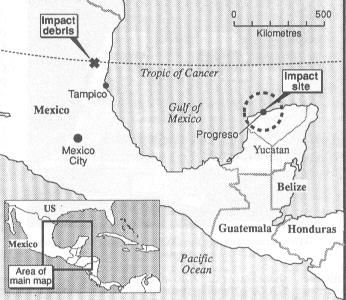
Location of the Chicxulub crater.
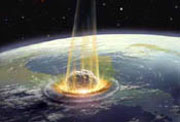
Cretaceous impact event.
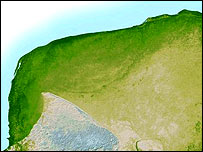
Shaded relief image of the northwest corner of the Yucatan Peninsula generated from Shuttle Radar Topography Mission data. Source: NASA/JPL.
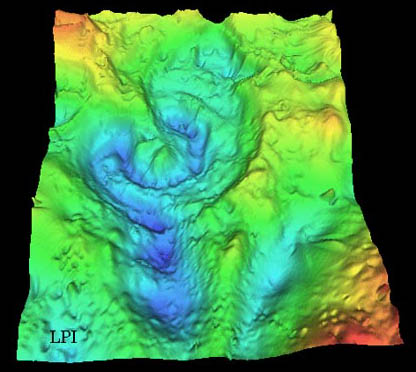
A 3D map of local gravity and magnetic field variations reveals the Chicxulub crater, now buried beneath tons of sediment. This view is looking down at the surface, from an angle of about 60°.
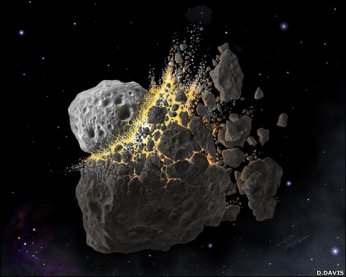
Results published in 2007 suggest that the impactor that wiped out the dinosaurs and other life forms on Earth 65 million years ago can been traced back to a break-up event in the main asteroid belt more than 100 million years earlier.
Chicxulub crater is a 180 kilometer-wide, submerged, multiringed impact crater straddling the northwest coastline of the Yucatán Peninsula in Mexico; it is named after a village located near its center (21° 20' N, 89° 30' W).
Demise of the dinosaurs
The Chicxulub crater is believed to be the result of the collision with an asteroid measuring some 10 to 20 kilometers across. The environmental effects that accompanied its formation are thought to have been implicated in the mass extinction at the end of the Cretaceous period, about 66 million years ago, in which the last of the dinosaurs, along with many other species, disappeared (see Cretaceous-Tertiary boundary).
However, there has been much debate about whether the Chicxulub impact was the main cause of the mass extinction or just a contributing factor.
Question of dates
In February 2004, an international group of scientists led by Gerta Keller, of Princeton University, published results, based on a core sample, that the Chicxulub crater predated the extinction of the dinosaurs by about 300,000 years. The authors argued that the impact did not wipe out the creatures, rather two or more collisions might have been responsible. Keller and her colleagues analyzed rock from their core using five separate indicators of age, including fossil planktonic organisms and patterns of reversals in Earth's magnetic field. The results suggested the crater was punched into Earth around a third of a million yr before the dinosaurs disappeared from the face of the planet. Keller and her team contended that their findings proved the Chicxulub impact did not by itself trigger the extinction of the great beasts. Instead, they argued that a cooling of the global climate shortly followed by a period of greenhouse warming placed enormous stress on the dinosaurs. This warming could have been triggered by carbon dioxide released by a massive eruption of lava seen today in the Deccan traps of India. The Chicxulub impact occurred during this warming period and, although the environmental effects were severe, it did not cause the extinction of the dinosaurs. The team believed a second impact, 300,000 years after the Chicxulub collision, finished off the creatures. The structure of the sea bed beneath the Indian Ocean suggests this second impact could have been there, Keller has indicated.
Not surprisingly, this controversial counter-hypothesis met with strong opposition. In particular, it ran counter to other lines of evidence that indicated that the Chicxulub crater formed at the K-T boundary. This evidence includes once-molten material laid down at the K-T boundary in rocks from Haiti which is similar to deposits from the Chicxulub crater. In addition, debris thrown out by this collision gets thicker the closer one approaches Chicxulub, like a trail pointing to the impact site. Additionally, an impact the size of Chicxulub occurs on Earth about every 100 million years. That two such impacts should occur within 300,000 years is statistically unlikely.
Debate settled?
In February 2013, an international team of scientists from the Berkeley Geochronology Center and University of California, Berkeley, Vrije University Amsterdam in the Netherlands, and the University of Glasgow, established that the last of the dinosaurs died out 66,038,000 years ago – give or take 11,000 years. This ties in closely with the date of the Chicxulub impact and leaves little room for doubt that the collision play a major role in the mass extinction. The team based their results on a study of strata, containing traces of debris from the asteroid impact, which lie close to the last fossil remains of dinosaurs.
Visible signs of the Chicxulub crater
The illustration to the right is a photo of the Yucatan Peninsula taken from the Space Shuttle and is one the very few pieces of surface evidence that survives from the cataclysm. The 3- to 5-meter-deep and 3- to 5-kilometer-wide trough traces weaknesses in the rock created by the space impactor. The trough is visible today because of instabilities in the limestone sediments that overlie the crater. The original offset would have been about a kilometer or so; today it is just a few meters. The collapse of numerous limestone caverns above the crater rim has resulted in an arcing chain of sinkholes – also visible in the shuttle radar image. They are the result of extensive erosion in the limestone. These cenotes, as they are called, are several meters across and were in fact used by the Mayans to make their sacrifices. Inside the crater the cenote population is less dense than it is outside. Exactly why the crater (which is buried a few hundred meters below surface) still has an effect on water flow is not clear.
Origin of the asteroid
According to a study1 published in the journal Nature in 2007, the Chicxulub crater was formed by an asteroid that had its origin in a great collision that took place in the main asteroid belt about 160 million years ago. The authors of the study, William Bottke and David Nesvorny from the Southwest Research Institute, Boulder, Colorado, and David Vokrouhlicky from Charles University, Czech Republic, used computer modeling to show that a surge in asteroid strikes on Earth in the last 100–200 million years was probably caused by the catastrophic disruption of a 170-km-wide asteroid by another space rock of less than half its size. This collision resulted in a group of asteroids known today as the Baptistina family. The computer simulation indicated that a number of the original asteroids from this family found their way into the inner solar solar system, resulting not only in the Chicxulub crater but also other impact craters on Venus, Mars, and the Moon, including, probably, the 85-kilometer-wide Tycho crater on the Moon 108 million years ago.
Chemical analysis of projectile material connected to the Chicxulub event is also said to tie its impactor to the type of rocks that make up the Baptistina family.
A review of the paper by Bottke et al, in the same issue of Nature, comments "It is a poignant thought that the Baptistina collision some 160 million years ago sealed the fate of the late-Cretaceous dinosaurs well before most of them had evolved."
Reference
1. Bottke, W. F., Vokrouhlicky, D., and Nesvorny, D. "An asteroid breakup 160 Myr ago as the probable source of the K/T impactor". Nature 449 , 48-53 (2007).


